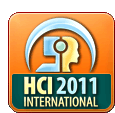T08: Cross-Cultural HCI /User-Experience Development
Full Day Tutorial
Aaron Marcus (short bio)
President, Aaron Marcus and Associates, Inc., Berkeley, California, USA
Objectives:
Participants will learn new terms and concepts to understand culture, dimensions of culture (e.g., power distance, individualism/collectivism, masculinity/femininity, uncertainty avoidance, and time orientation), and how these example dimensions relate to the design of user-interface components (metaphors, mental models, navigation, interaction, and appearance). We shall introduce additional culture dimensions, models, and dimensions (e.g., persuasion, trust, intelligence, cognition) that must be considered. We shall examine practical trade-offs in several multi-national companies' Web efforts, best-of-breed set of culture dimensions derived from expert opinions, how mobile devices from Asia and the USA exhibit culture differences, examples of culture differences and similarities of Web 2.0 and social networking Websites. Paper and pen exercises will provide experience in how to apply principles to practical challenges.
Content and Benefits:
Content:
Terminology of globalization, localization, and culture Visual examples of culture differences/similarities Culture theories, models, and dimensions Implications for user-interface design based on culture dimensions Use of culture models to predict behavior in usability inquiries Relation of culture to ethnography, usability, and testing Case study: Culture influence in corporate Web design standards Case study: culture-influenced PDA UI design for China Trends: Culture influence in mobile devices products/services for Asia/USA Best-of-breed culture dimension set Trends in Web 2.0 applications emphasizing social networks Where to learn more about culture theory and practice
Benefits:
Participants will learn about and practice using culture models and specific culture dimensions to design and evaluate human-computer user interfaces (HCIs/UIs). Examples will come from primarily from the Web and mobile devices, but the insights will be useful for all platforms, technologies, content, vertical markets, and user communities.
Target Audience:
Target audiences for the tutorial include professionals from software and hardware engineering, HCI/CHI/UI/UX designers and analysts/evaluators, visual/interaction designers, usability professionals, cognitive scientists, globalization/localization experts, ethnographers/anthropolotists, marketing personnel, and business managers who may know relatively little about the subject of culture models and their use in design and evaluation.
Links:
- Aaron Marcus and Associates, Inc.
- YouTube Customized Currency lecture
- YouTube Green Machine lecture
- Aaron Marcus' Modest Proposal to Reduce the Deficit: Customized Currency
- Seoul Design Market, South Korea Web Publication about Customized Currency (in Korean)
- Aaron Marcus: UX storytelling, about San Jose Police Communications System, pp. 197-204
- Design Jungle Interview with Aaron Marcus (in Korean)
Biography:

Link to Long Biography

